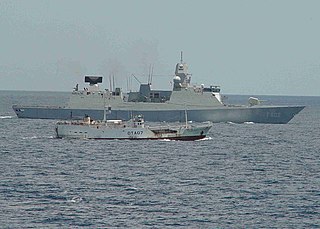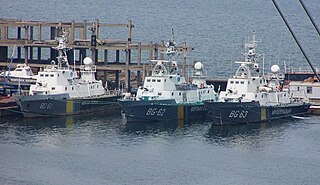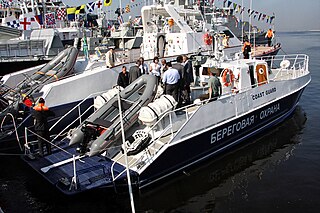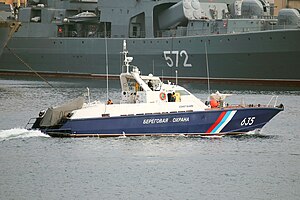
The United States Coast Guard (USCG) is the maritime security, search and rescue, and law enforcement service branch of the United States Armed Forces and one of the country's eight uniformed services. The service is a maritime, military, multi-mission service unique among the United States military branches for having a maritime law enforcement mission with jurisdiction in both domestic and international waters and a federal regulatory agency mission as part of its duties. It is the largest and most powerful coast guard in the world, rivaling the capabilities and size of most navies.

A coast guard or coastguard is a maritime security organization of a particular country. The term embraces wide range of responsibilities in different countries, from being a heavily armed military force with customs and security duties to being a volunteer organization tasked with search and rescue without law enforcement authority. In most countries, a typical coast guard's functions are distinct from those of the navy and the transit police, while in certain countries they have similarities to both.

A patrol boat is a relatively small naval vessel generally designed for coastal defence, border security, or law enforcement. There are many designs for patrol boats, and they generally range in size. They may be operated by a nation's navy, coast guard, police, or customs, and may be intended for marine, estuarine, or river environments.

The Japan Coast Guard is the coast guard of Japan.
The United States Coast Guard is the coastal defense, search and rescue, and maritime law enforcement branch of the United States Armed Forces and is one of the country's eight uniformed services. It carries out three basic roles, which are further subdivided into eleven statutory missions. The three roles are:

Maritime security operations (MSO) are the actions of modern naval forces to "combat sea-based terrorism and other illegal activities, such as hijacking, piracy, and slavery, also known as human trafficking." Ships assigned to such operations may also assist seafaring vessels in distress. These activities are part of an overall category of activities which fall short of open warfare called military operations other than war (MOOTW). MSO also involve the marine environmental protection, creating a safer and clean environment.

The Georgian Coast Guard is the maritime arm of the Georgian Border Police, within the Ministry for Internal Affairs. It is responsible for the maritime protection of the entire 310 km (190 mi) coastline of Georgia, as well as the Georgian territorial waters. The primary missions of the service are administration of the territorial waters, marine pollution protection, maritime law enforcement, search and rescue, port security and maritime defense. The former Georgian Navy was absorbed into the Coast Guard in 2009.

The Stenka class is the NATO reporting name for a class of patrol boats built for the Soviet Navy and Soviet Allies. The Soviet designation was Project 205P Tarantul. The boats are an anti-submarine (ASW) patrol boat version of the Osa-class missile boat.

The Svetlyak class, Russian designation Project 10410 Svetlyak, is a class of patrol boats designed and built in the Soviet Union and later in Russia, and currently being used primarily by the Russian Navy and Russian Coast Guard.

The Rubin class, Russian designation Project 22460 Okhotnik, is a class of Russian border patrol vessels being constructed for the Russian Coast Guard. It is designed to combat surface and airborne targets and threats. It can also conduct patrol and convoy escort duties. It is equipped with a Horizon Air S-100, a license-built version of the Austrian Camcopter S-100 helicopter unmanned aerial vehicle, which is intended for search, detection and identification of small high-speed sea targets at a distance of 150 km (93 mi) from the carrier vessel.

The Coast Guard of the Border Service of the FSB, previously known as the Maritime Units of the KGB Border Troops, is the coast guard of Russia.

The Mangust-class patrol boat, also known as Project 12150, is a Russian Coast Guard vessel. The patrol craft is designed to operate in coastal areas, ports, and other littoral areas, to perform missions like protection of territorial maritime borders, law enforcement, other defense missions, search and rescue, protection of fisheries, and enforcing rules of navigation.
The Mirage-class patrol vessel, also known as Project 14310, is a Russian Coast Guard vessel. The patrol craft is designed to operate in coastal areas, ports, and other littoral areas, to perform missions like protection of territorial maritime borders, law enforcement, counter-terrorism, detection and intercept smugglers or other threats, search and rescue, and protection of fisheries.

The Vosh-class river patrol craft, also known in Soviet designation as Project 1248 Moskit, which has the Project 12481 variant. Both are Russian Coast Guard vessels. The patrol craft is designed to operate in rivers and protect/secure Russian maritime borders, enforce navigational rules and other laws, search and rescue. They work alongside other patrol craft of the Russian Coast Guard and Navy, such as the Piyavka-class and the Ogonek-class river patrol craft.

The Piyavka-class river patrol boat, also known as Project 1249, is a Russian Coast Guard vessel. The patrol craft is designed to operate in rivers to secure and protect Russian maritime borders, enforce navigational laws and other law enforcement duties, and search and rescue. The patrol craft work alongside other Russian Coast Guard and Navy vessels, such as the Moskit-class and the Ogoniok-class river patrol craft. Its hull is not capable of breaking through heavy ice during the winter season.
The Sorum-class seagoing tugboat, also known as Project 745P in Russian Coast Guard service, is a seagoing tug that is currently in service in the Russian Coast Guard and was in other services at one point. These vessels will perform the standard missions of a seagoing tug boat with other missions such as protecting and patrolling Russian maritime borders, enforcing navigational rules and law enforcement, search and rescue, and fisheries protection.

The Ogonek-class river patrol craft, also known as Project 12130 Ogoniok river gunboat, is a Russian Coast Guard vessel. The patrol craft is designed to operate in rivers and perform various missions of the Russian Coast Guard like protecting Russian maritime borders, law enforcement, enforcement of navigation rules, search and rescue, and fisheries protection. These vessels work alongside other classes of Russian Coast Guard vessels, such as the Vosh-class and the Piyavka-class river patrol craft.
The Sokzhoy-class fast patrol boat, also known as Project 14230, is a Russian Coast Guard vessel. The patrol craft is designed to operate on the coast, rivers, lakes, ports and other littoral areas. It will perform standard Russian Coast Guard missions such as protection of Russian maritime borders, law enforcement, enforcement of navigational rules, search and rescue, and fisheries protection. Both boats, PSKR-500 and PSKR-501, are currently part of the Black Sea Fleet.

The Yaz-class small artillery craft, also known as Project 1208, is a Russian Coast Guard patrol craft. This gunboat is designed to operate in rivers to secure and protect Russian maritime borders, enforce navigational laws and other law enforcement duties, and search and rescue. The gunboats work alongside other Russian Coast Guard and Navy vessels, such as the Vosh-class and the Ogonek-class river patrol crafts. The single active vessel is assigned to the Amur-Ussuri River network.

The Raptor-class patrol boat, formally identified as Project 03160, is a series of Russian high-speed coastal patrol boats. Boats of the class belong to the 4th rank ships in the Russian Navy. This project was developed by the design bureau of JSC Leningrad Shipyard Pella on the instructions of the Russian Navy. The boats are built at the Pella shipyard in the town of Otradnoye, Leningrad Region. Due to the great similarity in appearance, the boats of the project can be confused with the Swedish CB90-class fast assault craft and other transport and landing boats of the 02510 BK-16 project, developed by the Kalashnikov concern and manufactured at Rybinsk shipyard.
















